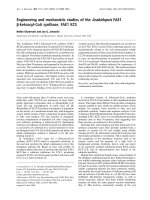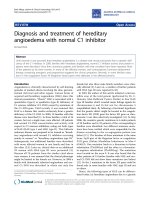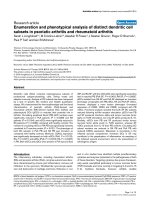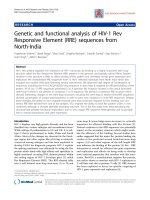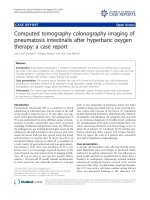Báo cáo y học: " Diagnosis and phylogenetic analysis of Orf virus from goats in China: a case report" pot
Bạn đang xem bản rút gọn của tài liệu. Xem và tải ngay bản đầy đủ của tài liệu tại đây (628.15 KB, 5 trang )
Zhang et al. Virology Journal 2010, 7:78
/>Open Access
CASE REPORT
BioMed Central
© 2010 Zhang et al; licensee BioMed Central Ltd. This is an Open Access article distributed under the terms of the Creative Commons
Attribution License ( which permits unrestricted use, distribution, and reproduction in
any medium, provided the original work is properly cited.
Case Report
Diagnosis and phylogenetic analysis of Orf virus
from goats in China: a case report
Keshan Zhang, Zhongxin Lu, Youjun Shang, Haixue Zheng, Ye Jin, Jijun He and Xiangtao Liu*
Abstract
Background: Orf virus (ORFV) is the etiological agent of contagious pustular dermatitis and is the prototype of the
genus Parapoxvirus (PPV). It causes a severe exanthematous dermatitis that afflicts domestic and wild small ruminants.
Case presentation: In the present study, an outbreak of proliferative dermatitis in farmed goats. The presence of ORFV
in tissue scrapings from the lips was confirmed by B2L gene polymerase chain reaction (PCR) amplification. The
molecular characterization of the ORFV was performed using PCR amplification, DNA sequencing and phylogenetic
analysis of the B2L gene.
Conclusion: The results of this investigation indicated that the outbreak was caused by infection with an ORFV that
was closely related genetically to Nantou (DQ934351), which was isolated from the Tai wan province of China and
Hoping (EU935106), which originated from South Korea in 2008. This is the first report of the phylogenetic analysis of
ORFV from goats in China.
Background
The ORFV is the prototype member of the genus
Parapoxvirus, which also includes pseudocowpox virus
(PCPV) in cattle, bovine papular stomatitis virus (BPSV)
in cattle, squirrel parapoxvirus (SPPV) and parapoxvirus
of red deer in New Zealand (PVNZ) [1,2]. Contagious
pustular dermatitis is a common viral skin disease that
occurs in a range of species, not only in wild ruminants
[3] but also in humans [4-6]. Humans with immunodefi-
ciency diseases, in particular, can develop serious infec-
tions [7]. The diseases caused by ORFV have worldwide
distribution and have been reported from many countries
[1].
The disease not only has an economic impact on farm-
ers worldwide but also has a considerable negative effect
on animal welfare. Infected animals are sickly, fail to
thrive, and are more susceptible to adventitious bacterial
infections [8]. The typical progress of orf in goats and
sheep moves from erythema, via vesicle formation, to
pustules and then to scabs. Characteristic of the disease
are proliferative and often self-limiting lesions on the skin
of the lips, on the oral mucosa and around the nostrils.
Lesions can also be found occasionally on the teats of
nursing animals and rarely on other organs[9]. Depend-
ing on the location of the lesions, animals may be unwill-
ing to nurse, eat, or walk [10]. Primary lesions usually
resolve spontaneously within 3-4 weeks [11]. The mortal-
ity rate related to orf is usually low, but it may be very
high in small ruminants, especially when bacterial or fun-
gal secondary infections occur [12,13]. The ORFV
genome consists of linear double-stranded DNA (134-
139 kb) [14]. The envelope gene (B2L) of the ORFV
encodes for a highly immunogenic envelope protein of
about 42 kDa [15]. A conventional PCR method that is
based on the amplification of the B2L gene has been used
for the detection of ORFV by PCR [1,16,17]. Molecular
characterization and phylogenetic analysis [1,18,19] have
been based on the complete sequence of the B2L gene.
In recent years, outbreaks of orf have occurred world-
wide [1]. Although outbreaks of orf have occurred in
China and have been confirmed, there are few reports
available of the detailed molecular characteristics and
phylogenetic analysis of the viruses involved. We report
an outbreak of ORFV infection in goats from the Hubei
province of the People's Republic of China in which the
ORFV was verified by PCR of the full-length B2L gene.
* Correspondence:
1
Lanzhou Veterinary Research Institute of Chinese Academy of Agriculture
Science, State Key Laboratory of Veterinary Etiological Biology, National Foot-
and-Mouth Disease Reference Laboratory, Key Laboratory of Animal Virology of
Ministry of Agriculture, Xujiaping No.1, Yanchangpu, Lanzhou, Gansu, 730046,
China
Full list of author information is available at the end of the article
Zhang et al. Virology Journal 2010, 7:78
/>Page 2 of 5
Comparative sequence analysis of the B2L gene from this
outbreak of orf was carried out, and the phylogenetic
relationship of the virus with other ORFV sequences
available in GenBank was determined. This is the first
report of the phylogenetic analysis of an ORFV in China
in comparison with other isolates from other regions.
Case presentation
The outbreak reported in this study originated on a goat
farm (114.52° E, 29.6° N) in the Hubei province of the
People's Republic of China. On 23 March 2009, the
farmer bought 655 goats from free-ranging herds and
transported them a distance of about 800 km to the farm.
On the third day, two goats presented with nodular
lesions on the lips, tongue and around the mouth; there
were 30 goats showed tubercular lesions three days later.
To 31 July 2009, the incidence was approaching 60% and
the mortality rate was 24.7% (162/655), although anti-
viral and antibiotic medicines were administered in the
drinking water, by intramuscular injection or orally.
Two goats with typical clinical signs were selected and
euthanized with an overdose of pentobarbital sodium.
Complete post mortem examinations were performed
and the macroscopic changes were recorded. Small sam-
ples of diseased tissue, about 6-8 mm
3
, were removed
carefully from the nodular lesions using a sterile scalpel
and stored in a sealed plastic tube with 50% glycerin
Phosphate Buffered Saline(PBS) at 20°C until analysis.
Primers designed for the amplification of the full length
of the B2L gene [20,21] were synthesized (Takara dalian
Co., Ltd). Tissue scrapings collected from the infected
goats were triturated in 0.1 M PBS (1:10 V/V) and freeze-
thawed twice between -20°C and 37°C, then placed at 4°C
overnight. After centrifugation at 3000 rpm for 20 min at
4°C, DNA was isolated from the clarified supernatant
using a Genomic DNA Purification Kit (Promega) and
used as template in the PCR procedures. Tissue scrapings
of healthy goat were treated with the same procedures
and used as negative control.
Comparison of the B2L sequences with those available
in the GenBank database was performed using the online
BLAST programs. The sequence identities of nucleotides
and amino acids were analyzed by the ClustalW method
[22]. A phylogenetic tree based on the deduced amino
acid sequences was constructed by the neighbor-joining
method with 1000 bootstrap replicates using MEGA ver-
sion 4.0 [23].
Discussion and Conclusion
The clinical signs seen in the goats included: multifocal to
coalescing papillary, verrucose, proliferative, and ulcer-
ated lesions in the epidermis of the muzzle and lips (Fig.
1). No visible lesions were found in other locations.
The orthodox methods of diagnosis that depend on
pathologic examinations and clinical signs are inaccurate,
virus isolation is thought to be a gold standard but it's
time-consuming[14]. With the development of molecular
biology, the PCR technique has become widely used to
amplify the desired genomic fragments from tissue speci-
mens, and it has become a powerful tool in molecular
diagnosis. The PCR method is able to diagnose ORFV
infection in field specimens from affected animals [2]. To
confirm whether the causative agent was present in skin
scrapings, PCR of the complete B2L gene was used in this
study. The expected PCR fragments, approximately 1137
bp in length, were obtained from DNA which had been
extracted from tissue scrapings; no fragments were
obtained from the negative control (Fig. 2). To ensure the
validity of the sequence as far as possible, DNA probest
Taq enzyme was used in the PCR, and the PCR products
were amplified directly from the skin scrapings. To gain
further information about the virus, we sequenced the
PCR product. The results showed that the B2L gene was
1137 bp in length and encoded 379 amino acids. The
G+C ratio was 63.3%, which is consistent with the whole
genome of the virus [1,24]. Sequences of the B2L gene of
the virus were submitted to NCBI GenBank and assigned
the accession number GU320351
.
Using nucleotide sequences of the complete B2L gene
stored in GenBank (Table 1), the phylogenetic relation-
ships were explored using the neighbor-joining method
and bootstrap analysis (Fig. 3). The results demonstrated
Figure 1 Representative clinical cases of ORFV infection in goats.
(A) Goat with severe proliferative lesions of ecthyma around the lips. (B
and C) Wart-like multiple nodules on the upper and lower eyelids. (D)
Copious serosanguineous discharge appeared when the nodules
burst.
Zhang et al. Virology Journal 2010, 7:78
/>Page 3 of 5
that the CHINA/Goat/2009 isolate obtained from this
outbreak was closest to the Nantou (DQ934351) isolate
obtained from the Tai wan province of China in 2006 and
the Hoping (EU935106) isolate, which originated from
South Korea in 2008 (Fig. 3). The percent identities and
diversities of the deduced amino acid sequence of the B2L
gene among the different strains of ORFV were calcu-
lated (Table 2) using the MegAlign function of DNAS-
TAR software. The sequence analysis revealed high
nucleotide and amino acid identity among the isolates
from different countries; they shared 95.3%-99.7%
sequence identity at the amino acid level. This is consis-
tent with the fact that the central region of Parapoxvi-
ruses is generally conserved.
Orf is endemic in China, although a vaccination pro-
gram has been performed to control the disease. Between
1980s and 1990s, orf occurred in eight provinces of China
including Qinghai, Gansu, Tibet, Xinjiang, Liaoning,
Jiangxi, Heilongjiang and Hebei. In recent years orf hap-
pened in the following provinces Innermongolia
(Jun.2005), Guangxi (Mar.2005), Shanxi (Apr.2005),
Fujian (Aug.2005), Jilin (Mar.2006), Jiangsu(Nov.2006)
and Beijing city (Apr.2006). More seriously, in 2005 there
were seven women and four men were infected by ORFV
in Fujian province. So, orf is a national zoonoses in China.
In this study, we diagnosed an outbreak of orf in Chinese
goats and determined its phylogenetic characteristics on
the basis of the complete gene sequence of the major
envelope protein (B2L). We conclude that the Chinese
ORFV involved in this outbreak was closely related phy-
logenetically to Nantou (DQ934351) and Hoping
(EU935106). This is the first report to provide phyloge-
netic information about an ORFV strain in China, which
will be of use for prospective studies in public health.
List of abbreviations
ORFV: Orf virus; PCPV: pseudocowpox virus; BPSV:
bovine papular stomatitis virus; SPPV: squirrel parapox-
virus; PVNZ: parapoxvirus of red deer in New Zealand;
PCR: polymerace chain reaction; PBS: phosphate buff-
ered solution; bp: base pair; kb: kilobase.
Competing interests
The authors declare that they have no competing interests.
Authors' contributions
XL was the leader of the project. KZ carried out most of the studies and drafted
the manuscript. JH and JY amplified the complete B2L gene. HZ, ZL and YS pro-
vided consultation and preparation of the final report. All authors read and
approved the final manuscript.
Figure 2 Agarose (0.8%) gel electrophoresis of major envelope
(B2L) gene fragment obtained by PCR, stained with ethidium bro-
mide. Lane 1: DNA ladder markers 2000 bp; Lanes 2 and 3: PCR prod-
ucts of complete B2L gene (1137 bp); Lane 4: negative control PCR
using PBS as template DNA.
Figure 3 Phylogenetic analysis based on deduced amino acid se-
quence of complete B2L gene. The phylogenetic tree was construct-
ed by the neighbor-joining algorithm using MEGA 4.0, and bootstrap
analysis was performed with 1000 trials. All sequences were collected
from GenBank. The red spot indicates CHINA ORFV, isolated in this
study.
Zhang et al. Virology Journal 2010, 7:78
/>Page 4 of 5
Table 1: Detailed information on the ORFV used in the analysis; " " indicates host species unknown.
S.No. Virus strains Country and year of
isolation
Accession Number Host species
1 NZ2/2005 New Zealand 2005 DQ184476
2 USA/Goat/2003 USA 2003 AY278208
Goat
3 USA/Vaccine/2003 USA 2003 AY278209
4 OV-IA82 USA 1982 AY386263
Lamb
5 OV-SA00 USA 2003 AY386264
Kid
6 USA/musk ox/2003 USA 2003 AY424969
Musk ox
7 USA/Sheep/2003 USA 2003 AY424970
Sheep
8 USA/Takin/2003 USA 2003 AY424971
Takin
9 India 82/04 India 2004 DQ263303
Goat
10 India 59/05 India 2005 DQ263304
Goat
11 India 67/04 India 2004 DQ263305
Sheep
12 India 79/04 India 2004 DQ263306
Sheep
13 Nantou CHINA tw 2006 DQ904351
Goat
14 Taiping CHINA tw 2007 EU327506
15 Hoping South Korea 2008 EU935106
Goat
16 ORFV/2009/Korea South Korea 2009 GQ328006
Dairy goat
17 NZ-2/1994 New Zealand1994 U06671
Sheep
18 CHINA/Goat/2009 China GU320351
Goat
Table 2: The percentage identities and diversities of deduced amino acid sequences of the B2L gene among ORFV strains.
12345 6 7 8 9 101112131415161718 Virus strains
1 99.5 98.7 97.6 96.3 97.4 99.5 97.1 97.1 97.6 97.6 98.4 98.2 96.8 97.1 97.4 96.6 96.8 1 CHINA Goat 2009
2 0.3 98.9 97.9 96.6 97.6 99.7 97.4 97.4 97.9 97.9 98.7 98.4 97.1 97.4 97.6 96.8 97.1 2 Hoping(EU935106)
3 1.1 0.8 98.2 96.8 97.4 98.9 97.6 97.6 97.6 98.2 98.4 98.2 97.4 97.6 97.9 97.1 97.4 3 India 59 05(DQ263304)
4 2.1 1.9 1.6 98.4 98.4 97.9 98.7 98.7 97.1 97.6 97.9 97.6 98.4 97.1 97.4 96.6 97.4 4 India 67 04(DQ263305)
5 3.5 3.2 3.0 1.3 97.1 96.6 97.4 97.4 95.8 96.3 96.6 96.3 97.1 95.8 96.0 95.3 96.0 5 India 79 04(DQ263306)
6 2.4 2.1 2.4 1.3 2.7 97.6 97.4 97.4 96.8 97.9 97.6 97.4 97.1 96.8 97.1 96.3 97.1 6 India 82 04(DQ263303)
7 0.3 0.0 0.8 1.9 3.2 2.1 97.4 97.4 97.9 97.9 98.7 98.4 97.1 97.4 97.6 96.8 97.1 7 Nantou (DQ904351)
8 2.7 2.4 2.1 1.1 2.4 2.4 2.4 99.7 97.1 98.2 97.9 97.6 99.5 98.2 98.4 97.6 98.4 8 NZ-2 1994(U06671)
9 2.7 2.4 2.1 1.1 2.4 2.4 2.4 0.0 97.1 98.2 97.9 97.6 99.5 98.2 98.4 97.6 98.4 9 NZ2 2005(DQ184476)
10 2.1 1.9 2.1 2.7 4.1 3.0 1.9 2.7 2.7 97.1 97.9 99.2 96.8 96.6 96.8 96.0 96.3 10 ORFV 2009Korea(GQ328006)
11 2.1 1.9 1.6 2.1 3.5 1.9 1.9 1.6 1.6 2.7 97.4 97.6 97.9 98.7 98.9 98.2 98.4 11 OV-IA82(AY386263)
12 1.6 1.3 1.6 2.1 3.5 2.4 1.3 2.1 2.1 2.1 2.7 98.4 97.6 97.4 97.6 96.8 97.1 12 OV-SA00(AY386264)
13 1.6 1.3 1.6 2.1 3.5 2.4 1.3 2.1 2.1 0.5 2.1 1.6 97.4 97.1 97.4 96.6 96.8 13 Taiping (EU327506)
14 3.0 2.7 2.4 1.3 2.7 2.7 2.7 0.3 0.3 3.0 1.9 2.4 2.4 97.9 98.2 97.4 98.2 14 USA Goat 2003(AY278208)
15 2.7 2.4 2.1 2.7 4.1 3.0 2.4 1.6 1.6 3.2 1.1 2.7 2.7 1.9 98.9 98.2 98.4 15 USA musk ox 2003(AY424969)
16 2.4 2.1 1.9 2.4 3.8 2.7 2.1 1.3 1.3 3.0 0.8 2.4 2.4 1.6 0.8 98.9 98.9 16 USA Sheep 2003(AY424970)
17 3.2 3.0 2.7 3.2 4.6 3.5 3.0 2.1 2.1 3.8 1.6 3.2 3.2 2.4 1.6 0.8 98.2 17 USA Takin 2003(AY424971)
18 3.0 2.7 2.4 2.4 3.8 2.7 2.7 1.3 1.3 3.5 1.3 3.0 3.0 1.6 1.3 0.8 1.6 18 USA Vaccine 2003(AY278209)
12345 6 7 8 9 101112131415161718
Zhang et al. Virology Journal 2010, 7:78
/>Page 5 of 5
Acknowledgements
Financial support was provided by the National Modern Meat Caprine Indus-
trial Technology System (nycytx-39), and the Integration and demonstration of
foot-and-mouth disease comprehensive prevention and control of national
technological support project (2006BAD06A17). Authors wish to thank the
journal editors and anonymous reviewers for their editing and revision the
manuscript.
Author Details
Lanzhou Veterinary Research Institute of Chinese Academy of Agriculture
Science, State Key Laboratory of Veterinary Etiological Biology, National Foot-
and-Mouth Disease Reference Laboratory, Key Laboratory of Animal Virology of
Ministry of Agriculture, Xujiaping No.1, Yanchangpu, Lanzhou, Gansu, 730046,
China
References
1. Hosamani M, Bhanuprakash V, Scagliarini A, Singh RK: Comparative
sequence analysis of major envelope protein gene (B2L) of Indian orf
viruses isolated from sheep and goats. Vet Microbiol 2006, 116:317-324.
2. Inoshima Y, Morooka A, Sentsui H: Detection and diagnosis of
parapoxvirus by the polymerase chain reaction. J Virol Methods 2000,
84:201-208.
3. Pedersen AB, Jones KE, Nunn CL, Altizer S: Infectious diseases and
extinction risk in wild mammals. Conserv Biol 2007, 21:1269-1279.
4. Hubner G, Loewe KR, Dittmar FK: [Human infection by the virus of
contagious pustular dermatitis of sheep (author's transl)]. Dtsch Med
Wochenschr 1974, 99:2392-2394.
5. Paiba GA, Thomas DR, Morgan KL, Bennett M, Salmon RL, Chalmers R,
Kench SM, Coleman TJ, Meadows D, Morgan-Capner P, et al.: Orf
(contagious pustular dermatitis) in farmworkers: prevalence and risk
factors in three areas of England. Vet Rec 1999, 145:7-11.
6. Carr RW: A case of orf (ecthyma contagiosum; contagious pustular
dermatitis) contracted by a human from a wild Alaskan mountain goat.
Alaska Med 1968, 10:75-77.
7. Ara M, Zaballos P, Sanchez M, Querol I, Zubiri ML, Simal E, Horndler C:
Giant and recurrent orf virus infection in a renal transplant recipient
treated with imiquimod. J Am Acad Dermatol 2008, 58:S39-40.
8. Gallina L, Dal Pozzo F, Mc Innes CJ, Cardeti G, Guercio A, Battilani M, Ciulli
S, Scagliarini A: A real time PCR assay for the detection and
quantification of orf virus. J Virol Methods 2006, 134:140-145.
9. Vikoren T, Lillehaug A, Akerstedt J, Bretten T, Haugum M, Tryland M: A
severe outbreak of contagious ecthyma (orf) in a free-ranging musk ox
(Ovibos moschatus) population in Norway. Vet Microbiol 2008,
127:10-20.
10. Meynink SE, Jackson PG, Platt D: Treatment of intraoral orf lesions in
lambs using diathermy and cryosurgery. Vet Rec 1987, 121:594.
11. McKeever DJ, Jenkinson DM, Hutchison G, Reid HW: Studies of the
pathogenesis of orf virus infection in sheep. J Comp Pathol 1988,
99:317-328.
12. Haig DM, Mercer AA: Ovine diseases. Orf. Vet Res 1998, 29:311-326.
13. Robinson AJ: Prevalence of contagious pustular dermatitis (orf) in six
million lambs at slaughter: a three-year study. N Z Vet J 1983,
31:161-163.
14. Chan KW, Lin JW, Lee SH, Liao CJ, Tsai MC, Hsu WL, Wong ML, Shih HC:
Identification and phylogenetic analysis of orf virus from goats in
Taiwan. Virus Genes 2007, 35:705-712.
15. Sullivan JT, Mercer AA, Fleming SB, Robinson AJ: Identification and
characterization of an orf virus homologue of the vaccinia virus gene
encoding the major envelope antigen p37K. Virology 1994,
202:968-973.
16. Tikkanen MK, McInnes CJ, Mercer AA, Buttner M, Tuimala J, Hirvela-Koski V,
Neuvonen E, Huovilainen A: Recent isolates of parapoxvirus of Finnish
reindeer (Rangifer tarandus tarandus) are closely related to bovine
pseudocowpox virus. J Gen Virol 2004, 85:1413-1418.
17. Inoshima Y, Murakami K, Yokoyama T, Sentsui H: Genetic heterogeneity
among parapoxviruses isolated from sheep, cattle and Japanese
serows (Capricornis crispus). J Gen Virol 2001, 82:1215-1220.
18. Guo J, Rasmussen J, Wunschmann A, de La Concha-Bermejillo A: Genetic
characterization of orf viruses isolated from various ruminant species
of a zoo. Vet Microbiol 2004, 99:81-92.
19. Guo J, Zhang Z, Edwards JF, Ermel RW, Taylor C Jr, de la Concha-Bermejillo
A: Characterization of a North American orf virus isolated from a goat
with persistent, proliferative dermatitis. Virus Res 2003, 93:169-179.
20. Pettersson B, Uhlen M, Johansson KE: Phylogeny of some mycoplasmas
from ruminants based on 16S rRNA sequences and definition of a new
cluster within the hominis group. Int J Syst Bacteriol 1996, 46:1093-1098.
21. Tryland M, Klein J, Nordoy ES, Blix AS: Isolation and partial
characterization of a parapoxvirus isolated from a skin lesion of a
Weddell seal. Virus Res 2005, 108:83-87.
22. Thompson JD, Higgins DG, Gibson TJ: CLUSTAL W: improving the
sensitivity of progressive multiple sequence alignment through
sequence weighting, position-specific gap penalties and weight
matrix choice. Nucleic Acids Res 1994, 22:4673-4680.
23. Tamura K, Dudley J, Nei M, Kumar S: MEGA4: Molecular Evolutionary
Genetics Analysis (MEGA) software version 4.0. Mol Biol Evol 2007,
24:1596-1599.
24. Delhon G, Tulman ER, Afonso CL, Lu Z, de la Concha-Bermejillo A,
Lehmkuhl HD, Piccone ME, Kutish GF, Rock DL: Genomes of the
parapoxviruses ORF virus and bovine papular stomatitis virus. J Virol
2004, 78:168-177.
doi: 10.1186/1743-422X-7-78
Cite this article as: Zhang et al., Diagnosis and phylogenetic analysis of Orf
virus from goats in China: a case report Virology Journal 2010, 7:78
Received: 20 January 2010 Accepted: 25 April 2010
Published: 25 April 2010
This article is available from: 2010 Zhang et al; licensee BioMed Central Ltd. This is an Open Access article distributed under the terms of the Creative Commons Attribution License ( ), which permits unrestricted use, distribution, and reproduction in any medium, provided the original work is properly cited.Virology Journal 2010, 7:78
